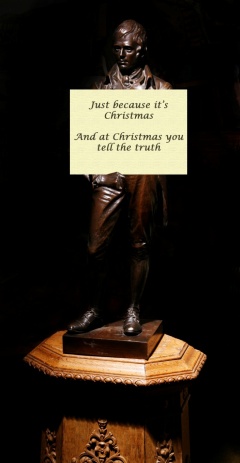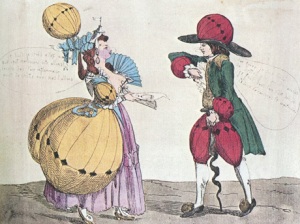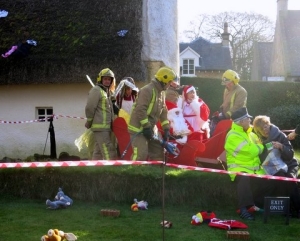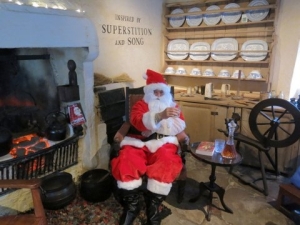Month: December 2013
Thrack Hooks
Thrack Hooks, or sickles, were used by the young Robert Burns as he went about his daily agricultural duties. Born into a farming family and raised on a smallholding until the age of seven, his upbringing not only earned him the nickname of ‘Ploughman Poet’, but hugely influenced his later works, probably inspiring the love of nature apparent in poems such as ‘To a Mouse’. Sickles were used during the harvest to chop the stems of crops such as barley, wheat and corn, and it was with thrack hooks that, in 1774, a fourteen year old Robert removed nettle stings from the hand of his work partner, a local girl and ‘bewitching creature’ probably named Helen Kilpatrick. This awakened in him a ‘certain delicious Passion’ and inspired him to write his first song: ‘O once I lov’d a bonnie lass’ or ‘Handsome Nell’. Burns’s modest upbringing caused him to doubt his abilities as a poet, but after learning that a local farmer had written a song about his sweetheart, he decided to try it out himself… and never looked back! Unfortunately for our Bard, the lady in question did not return his feelings and the poem was not written down until twelve years later, on this very manuscript.
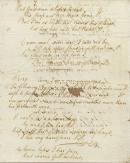
It is now part of the Stair manuscript collection, a group of eight poems and songs Burns copied and sent to Mrs Alexander Stewart of Stair in 1786, and remains a lasting legacy of the farm girl who inspired Burns to write.
In 1787 Robert Burns spent the Christmas period exchanging letters with Agnes MacLehose. Their new love affair was unfolding, with Agnes revealing her unhappy marriage and their agreement to take the Arcadian names of Sylvander and Clarinda.
On 28th December Robert Burns made an unsuitable outpouring of love and was fairly insincere in his contrition over Agnes’ or perhaps a more disapproving audience’s imagined displeasure:
I do love you if possible better for having so fine a taste and turn for Poesy.
I have again gone wrong in my usual unguarded way, but you may erase the word, and put esteem, respect, or any other tame Dutch expression you please in its place.
I like to think of this as significant within a certain genre of love declarations, not because of his indiscretion but the time of year in which he made it. It is the Christmas-inspired ill-advised declaration of love, made recognisable by a Christmas film that is almost unavoidable at this time of year; Richard Curtis’s Love Actually. OK, so perhaps such slushy Christmas spirit wasn’t something so commonly encountered in 18th Century Scotland as it is now, but it’s an amorous story fraught with the problems worthy of a scene in one of our favourite Christmas films nonetheless.
Merry Christmas!
Banned Burns Brand
At first glance there might not seem to be a lot in common between Scotland’s bard Robert Burns and comedian Russell Brand past the accusations of womanising and a discredited or sadly real problem with addiction respectively (and of course the UNCANNY similarity between their names…).
And yet…
Burns enjoyed rude songs and smutty poems and The Merry Muses, although not intended for public consumption, since its publication shortly after his death has been difficult for some to reconcile with their perceptions of him and was banned in the UK until 1965. It is no great stretch to see a similarity in Brand’s style of comedy but there is a more interesting connection to consider. It has recently come to light that Russell Brand’s memoir, Booky Wook 2, was banned from an inmate of Guantanamo Bay. Whilst the book itself is not particularly contentious, the reasons for it being banned are entirely relevant to Burns and his relevance to our contemporary world.
Burns was a noted advocate for freedom, although a freedom negotiated within the 18th century mores and societal norms that allowed him to briefly consider becoming a Bookkeeper for a plantation in Jamaica before his circumstances changed for the better. For the prisoners of Guantanamo Bay, the censorship of what books they receive and what they are allowed to communicate could be seen as the removal of freedoms Burns felt were paramount.
Here’s freedom to them that wad read,
Here’s freedom to them that wad write,
There’s nane ever fear’d that the truth should be heard,
But they whom the truth would indite.
The prisoners have written their own poetry, some of which is now collected in an anthology Poems from Guantanamo. They are the poems that have made it past strict censorship.
“TO MY FATHER” BY ABDULLA THANI FARIS AL ANAZI
Two years have passed in far-away prisons,
Two years my eyes untouched by kohl.
Two years my heart sending out messages
To the homes where my family dwells,
Where lavender cotton sprouts
For grazing herds that leave well fed.
A comparable project has been undertaken in collaboration between the Robert Burns Birthplace Museum and Creative Scotland; with Kevin Williamson leading poetry workshops with some prisoners of HMP Kilmarnock that have also resulted in an anthology of poetry, Independent Minds: Prison, Poems and Politics. Although these are of course different circumstances, the creative freedom of expression that writing poetry has given both these groups of prisoners is something Robert Burns understood and we should not underestimate now.
‘Outside Time’ by Stephen
Vengeance and Incarceration.
Punishment and retribution.
Did I not offend enough.
To be considered with compassion.
‘Perhaps this Christian volume is the theme…’
Aside Posted on Updated on
The priest-like father reads the sacred page,
How Abram was the friend of God on high;
Or Moses bade eternal warfare wage,
With Amalek’s ungracious progeny;
Or how the royal bard did groaning lie
Beneath the stroke of Heaven’s avenging ire;
Or Job’s pathetic plaint, and wailing cry;
Or rapt Isaiah’s wild, seraphic fire;
Or other holy seers that tune the sacred lyre.
Robert Burns, The Cotter’s Saturday Night

Bibles form key building blocks throughout the life of Scotland’s Bard. His father William was an extremely religious man, and Burns credits him with the inspiration for the ‘priest-like father’ described in the Cotter’s Saturday Night. This religious upbringing, especially when mixed with William’s fierce desire to see his children receive a good education, would have had a huge impact on the young Bard, although as we see in other poems he didn’t always agree with the views of the Kirk itself!
However, this Bible did not just have religious significance. William wrote the names and birthdates of his and Agnes’s children inside the front cover, creating a touching memento for themselves and leaving a lasting legacy for Burns’s followers in the absence of a birth certificate.

This tradition was later carried on by Robert in his own family Bible, inscribing the names of himself, Jean Armour and eight of their nine children within it. His youngest son, Maxwell, was born on the day of the poet’s funeral and so was not entered by the poet himself.

Bibles featured at other key moments in the life of the Bard. This Bible was published by the same printer as published Burns’s Kilmarnock edition, and the book would have played a key role in the Masonic rituals young Robert took part in after he joined the Freemasons.

However, it is perhaps this Bible that was the most poignant to Burns himself. As the poet was gathering together subscriptions to support his first volume of poetry in 1786, he began an intense love affair with ‘Highland Mary’, probably a woman called Margaret Campbell. The Bard presented Mary with this two volume Bible, which some believe may have equated to a form of marriage vow. Inside the volume is Robert Burns’s Masonic mark, the words ‘Robert Burns Mossgavill’ and some Bible verses in the poet’s handwriting. A lock of hair which is thought to be Highland Mary’s was also found in the volume.
However, the affair was destined to be short-lived. Soon after receiving the Bible, Margaret set out to Greenock to visit her family, and died shortly afterwards, possibly while giving birth to Burns’s child. In many roles, be it recording birthdays, forming the centrepiece of ritual, or constituting a heartfelt gift to a lover, the ‘Christian volume’ (The Cotter’s Saturday Night) really did constitute a theme in the life of Robert Burns, and features prominently in RBBM’s collections.
Flichts o fancy
On December 17th 1903 (110 years ago), brothers Orville and Wilbur Wright made their first successful flight with a mechanically-propelled aeroplane, and today is celebrated as ‘Wright Brothers Day’ in the United States. Air-travel has advanced significantly in the past century, but still people are fascinated (or terrified) by the idea of taking to the skies.
Robert Burns was writing a hundred years before the Wright brothers invented their flying machine, yet the appeal of flight still features in his poetry, and innovations in flight were being made in Burns’ lifetime. Coincidentally, today is also the birthday of Scotland’s very own aeronaut. James Tytler (born today 1745) was the editor of the Encyclopaedia Britannica (2nd ed), and in 1784 became the first person in Britain to travel in a hot-air balloon. Unfortunately for him, Tytler’s flights were soon overshadowed by the flamboyant voyages of Italian aeronaut, inventor and adventurer, Vincenco Lunardi. Lunardi carried out five hot-air balloon flights in Scotland in 1785.
These flights so captured the public imagination that Britain underwent a craze called Balloonomania, this spawned balloon poems, balloon skirts, and even a large balloon-shaped hat named ‘the Lunardi bonnet’. Burns was not immune to eighteenth century pop culture, and made reference to the Lunardi bonnet when admonishing the eponymous parasite in ‘To a Louse’:
I wad na been surpris’d to spy
You on an auld wife’s flainen toy;
Or aiblins some bit dubbie boy,
On’s wyliecoat;
But Miss’ fine Lunardi! fye!
How daur ye do’t?
In the poem, Burns was mocking the bonnet-wearer for looking so ridiculous, Lunardi bonnets were certainly not sensible headwear. Despite the silliness of Balloonomania, even Burns understood the romance in being able to fly away. Flight offers a way for humans to escape their problems, to fly away somewhere over the rainbow. In the poem ‘On scaring some water-fowl in Loch Turit’ Burns advises the birds – and the reader – to escape the cruelty of humans by flying away :
Swiftly seek, on clanging wings,
Other lakes and other springs ;
And the foe you cannot brave,
Scorn at least to be his slave.
So today we say ‘well done’ to the Wright brothers, ‘happy birthday to’ James Tytler, ‘buon viaggio’ to Vincenzo Lunardi, and ‘the sky’s the limit’ to everyone else.
SANTA’S SLEIGH LOST IN ALLOWAY
On a derk stormy nicht in Burns statue square,
The wind was a–whistling in bonnie auld Ayr.
The fairy was perching on top of the tree,
And spreiding her magic as far as the sea.
When jingling and jangling along came a sleigh,
With lood hertie gollers of ‘Get oot the way!’
The Christmas tree fairy had barely keeked round,
When a sleigh-full of Christmas sped past to the ground!
The fairy’s best wand was snapped in the fray,
But the sleigh kept on streeking t’wards auld Alloway.
Now Santa is staying in Robert Burns’s hoose,
His favourite new poem is Burns’s ‘Tae a moose’.
The fairy is mending her wand in the Spence,
While Mrs Claus stirs in the puddings’ twa pence.
A magical kiss will save Christmas day,
Get the elves back to Lapland and cloot up the sleigh!
If you hear ower Alloway jingles on high,
Then Santa’s set off, leuk up to the sky!
Redd up all your stockings, line up the mince pies
And come to the Cottage for a Santa Surprise…
Christmas, Crafts and Cyclamen
Christmas has well and truly arrived this week at Burns Cottage, with a whole host of events getting underway. Our fantastic volunteers have worked hard to bring visitors two fairs; one selling festive arts and crafts in conjunction with our monthly farmer’s market, and the other selling Christmas plants including cyclamen, holly sprigs and wreaths! A lot of time and effort went into creating these displays and they flew off the shelves, spreading some Christmas cheer to the neighbourhood. We would like to say a big thank you to everybody who helped out with the events, and also to everyone who came along on the day!
Elsewhere, Burns Cottage has been playing host to Santa Claus, Mrs Claus and various little helpers, who mistakenly ended up in Alloway after taking a wrong turning on the way back from their holidays. Christmas preparations are firmly underway, with everybody’s letters being re-directed from the North Pole. Although Santa’s arm is currently in a sling, the doctor assures us he will be fighting fit again by Christmas Eve, so don’t forget to leave out plenty of mince pies and carrots! Again a big thanks to all our volunteers and staff who have made Santa’s stay so comfortable… who knows, he may even visit us again next year!
We are also preparing for our Alloway1759 celebrations at the end of January, so watch this space for further information on the events and activities we will be running then… it promises to be a fantastic weekend for all.
We at Robert Burns Birthplace Museum hope you all have a very Merry Christmas and a Happy New Year!
Alloway Primary Takeover (The Film)
Link Posted on Updated on
Alloway Primary Takeover (The Film)
P6 of Alloway Primary took over the Robert Burns Birthplace Museum for a day! After a run up of only 3 days of training in class led by museum staff they were greeting visitors, leading object handling sessions, live tweeting and showing passers by how to make their own quill pens. Some of the pupils made short videos to show our visitors what they got up to and you can see the highlights by following the title link.


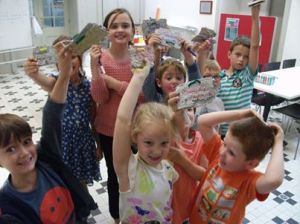
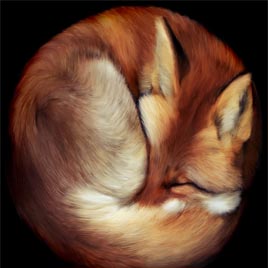 • November brought the opening of our new exhibition Savage and Tender, accompanied by a special visit from a certain John Barrowman! This exhibition will run until the 23rd March so don’t miss the opportunity to catch it in the New Year.
• November brought the opening of our new exhibition Savage and Tender, accompanied by a special visit from a certain John Barrowman! This exhibition will run until the 23rd March so don’t miss the opportunity to catch it in the New Year.
